









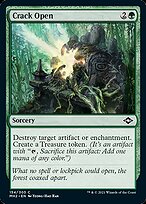


























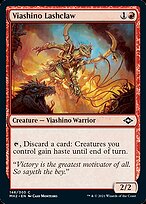




























Modern Horizons 2 is a large set with 101 commons, 100 uncommons (20 of which are reprints), 78 rares (18 of which are new-to-Modern reprints), 24 mythic rares (4 of which are reprints), and two variations of each standard basic land (not included in boosters). The new-to-Modern reprints are collated separately; ignoring these, the size is similar to contemporary sets. Foil cards are included in booster packs with advertised rate of 33% of boosters. The set was printed in English in the USA, Belgium, and Japan.
Modern Horizons 2 was sold in 15 card draft boosters (which contain an additional ad card or double-faced card placeholder). Draft booster boxes have 36 packs.
The US printing uses sequential collation with C1/C2 common collation in the new style similar to the style first seen in Zendikar Rising.
Packs are front-facing and have common-uncommon-rare ordering followed by an ad card. There are 10 commons, 3 uncommons, and 1 rare. Between the uncommons and the rare is a new-to-Modern reprinted card (which can be uncommon, rare, or mythic). If there is a foil, it will displace a common and appear after the rare.
| 10 Commons | 3 Uncommons | 1 Reprint | 1 Rare | 1 Ad Card | |
| 9 Commons | 3 Uncommons | 1 Reprint | 1 Rare | 1 Foil | 1 Ad Card |
Packs are evenly split between C1 commons and C2 commons. C1 packs have 3 A commons followed by 1-2 B commons and 5-6 C commons. Non-foil C2 packs have 3-4 A commons followed by 2-3 B commons and 3-4 C commons. (I haven't observed 3A + 2B.)
When a foil appears in a pack, it will displace a common card. All foils appear in C2 packs. These packs can be 4A+2B, 3A+3B, or 3A+2B.
The uncommons are divided into an A run and a B run. Each run has 40 distinct cards each appearing three times. Half of packs have three consecutive cards from the A run and the other half have three from the B run. For cards that have special versions, one of the three copies in the run is the special version. Note that under a single pack model, there is no reason way to choose which run should be called "A", but the runs are disambiguated by box collation.
The new-to-Modern reprints are all on one sheet. But, the variants of these cards (including old-border, sketch, and borderless) are not on the sheet. The sheet has one copy of each mythic, two copies of each rare, and four copies of each uncommon. Occasionally, a variant will appear in this slot instead. This is rare (the rate seems to be less than one per box).
There are four rare sheets. There is one sheet with two copies of each of the 60 (not new-to-Modern) rares. These are the normal versions of these cards. There is another sheet with (probably) six copies of each of the 20 (not new-to-Modern) mythics. The third sheet has all the non-borderless variant cards, and the fourth sheet has all the borderless variants. The rates for these sheets are, respectively, 78%, 13%, 8%, and 1%. Looking at the non-variant sheets, individual rares appear twice as often as individual mythics, and the mythic rate is 1/7. The arrangements of the variant sheets are less clear, but probably each rare appears twice and each mythic appears once. If there were 120 cards on the non-borderless variant sheet, this would make mythics on both variant sheets equally rare, but probably the sheet is not quite so full.
Notably, the way variants are handled in the reprint and rare slots means that normal versions cards are equally rare whether or not the have a variants, and variants appear in addition. This is a change from earlier sets.
The A common run consists of 33 different cards each appearing twice. These cards are blue, red, and green (but they don't strictly alternate). The choice of first card is mostly arbitrary.
 |  |  |  |  |  |  |  |  |  |  |
 |  |  |  |  |  |  |  |  |  |  |
 |  |  |  |  |  |  |  |  |  |  |
 |  |  |  |  |  |  |  |  |  |  |
 |  |  |  |  |  |  |  |  |  |  |
 |  |  |  |  |  |  |  |  |  |  |
The B common run consists of 22 different cards each appearing three times. The cards alternate between white and black. For cards with sketch or old border versions, one of the three copies is the special version. The choice of first card is mostly arbitrary.
 |  | 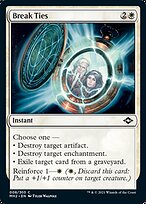 |  |  |  |  |  |  |  |  |
 | 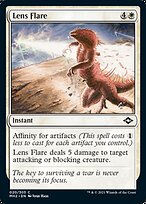 |  | 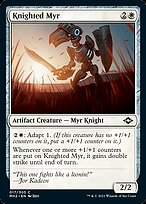 |  |  | 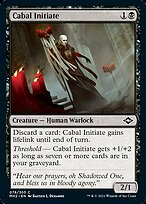 |  |  |  |  |
 |  |  |  |  |  |  |  |  |  |  |
 |  |  |  |  |  |  |  |  |  |  |
 |  |  |  |  |  |  |  |  |  |  |
 |  |  |  |  |  |  |  |  |  |  |
The C1 common run consists of 27 different cards each appearing twice plus Bottle Golems, the short-printed common. The choice of first card is mostly arbitrary.
 | 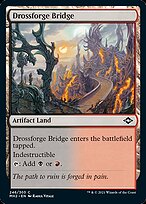 |  |  | 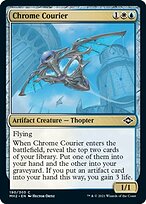 | 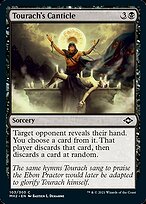 |  |  |  |  |  |
 |  |  |  |  |  |  |  |  |  |  |
 |  |  |  |  |  |  |  |  |  |  |
 |  |  |  |  |  |  |  |  |  |  |
 |  |  |  |  |  |  |  |  |  |  |
The C2 common run consists of 18 different cards each appearing three times plus Bottle Golems, the short-printed common. For cards with sketch or old border versions, one of the three copies is the special version. The choice of first card is mostly arbitrary.
 |  |  |  |  |  |  |  | 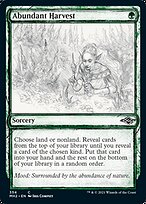 |  |  |
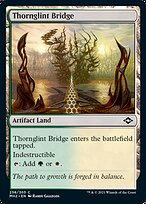 |  |  |  |  |  |  |  |  |  | 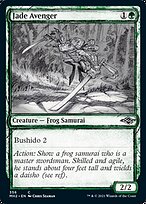 |
 |  |  |  |  |  |  |  |  |  |  |
 |  |  |  |  |  |  |  |  |  |  |
 | 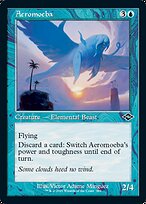 |  |  |  |  |  |  |  |  |  |
The A uncommon run consists of 40 different cards each appearing three times. For cards that have a special version, one of the three copies is the special version. The choice of first card is mostly arbitrary.
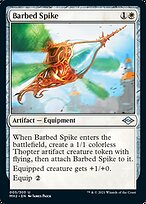 |  |  |  |  |  |  |  |  |  | 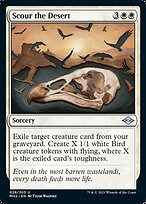 |
 | 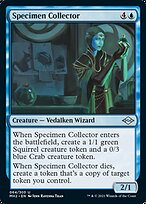 |  |  | 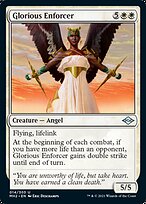 |  |  |  |  |  |  |
 | 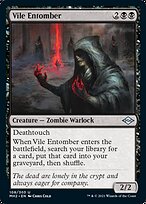 | 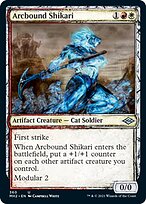 |  | 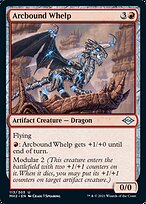 |  |  |  |  |  |  |
 |  |  |  |  |  |  |  |  |  |  |
 |  |  |  |  |  |  |  |  |  |  |
 |  |  |  |  |  |  |  |  | 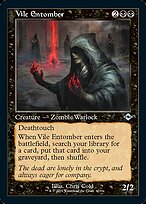 |  |
 |  |  |  |  |  |  |  |  |  |  |
 |  |  |  |  |  |  |  |  |  |  |
 | 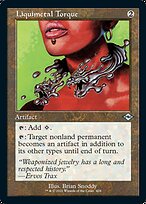 |  |  |  |  |  |  |  |  |  |
 |  |  |  |  |  |  |  |  |  |  |
 |  |  |  |  |  |  |  |  |  |
The B uncommon run consists of 40 different cards each appearing three times. For cards that have a special version, one of the three copies is the special version. The choice of first card is mostly arbitrary.
 |  |  |  |  | 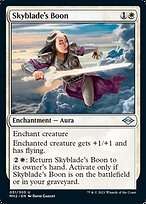 |  |  |  |  | 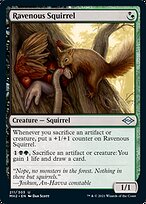 |
 | 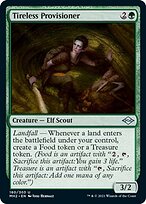 | 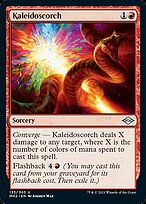 |  |  |  |  |  |  |  |  |
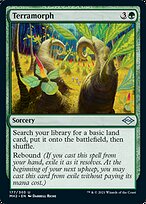 | 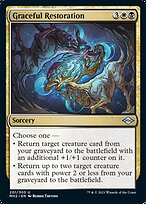 |  |  |  |  |  |  |  |  |  |
 |  |  |  |  |  |  |  |  |  |  |
 |  |  |  |  |  | 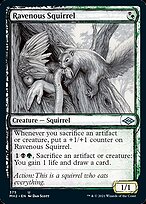 |  |  |  |  |
 |  |  |  |  |  |  |  |  |  |  |
 |  |  |  | 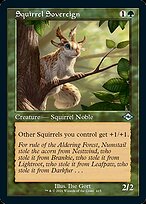 |  |  |  |  |  |  |
 |  |  |  |  |  |  |  |  |  |  |
 |  |  |  |  |  |  |  |  |  |  |
 |  |  |  |  |  |  |  |  |  |  |
 |  |  |  |  |  |  |  |  |  |
All of the marketing cards in Modern Horizons 2 have a token on the front face. They are printed in a 121 card run with items appearing different numbers of times.
 |  |  |  |  |  |  |  |  |  |  |
 |  |  |  |  |  |  |  |  | 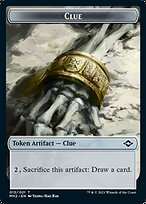 |  |
 |  |  |  |  |  |  |  |  |  |  |
 |  |  |  |  |  |  |  |  |  |  |
 |  |  |  |  |  |  |  |  |  |  |
 |  |  |  |  |  |  |  |  | 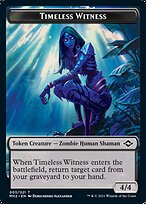 |  |
 |  |  |  |  |  |  |  |  |  |  |
 |  |  |  |  |  |  |  |  |  |  |
 |  |  |  |  |  |  |  |  |  |  |
 |  |  |  |  |  |  |  |  |  |  |
 |  |  |  |  |  |  |  |  |  |  |
| Token Rarity | ||
|---|---|---|
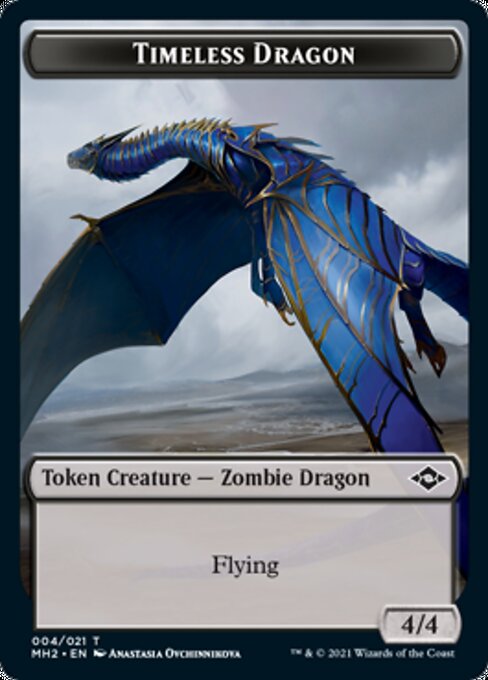 Timeless Dragon × 1 Timeless Dragon × 1 |  Construct × 2 Construct × 2 |  Elemental × 2 Elemental × 2 |
 Goblin × 2 Goblin × 2 | 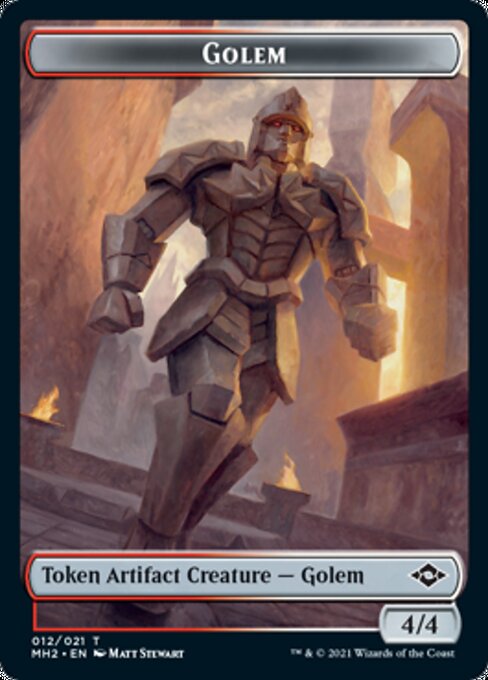 Golem × 2 Golem × 2 |  Insect × 2 Insect × 2 |
 Phyrexian Germ × 2 Phyrexian Germ × 2 | 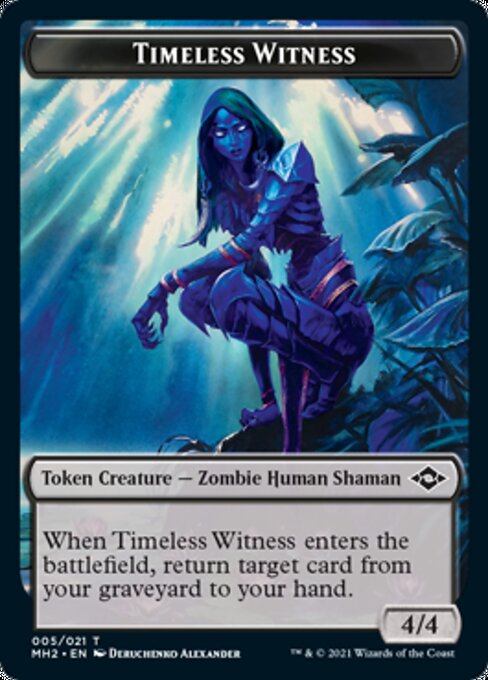 Timeless Witness × 2 Timeless Witness × 2 |  Zombie × 2 Zombie × 2 |
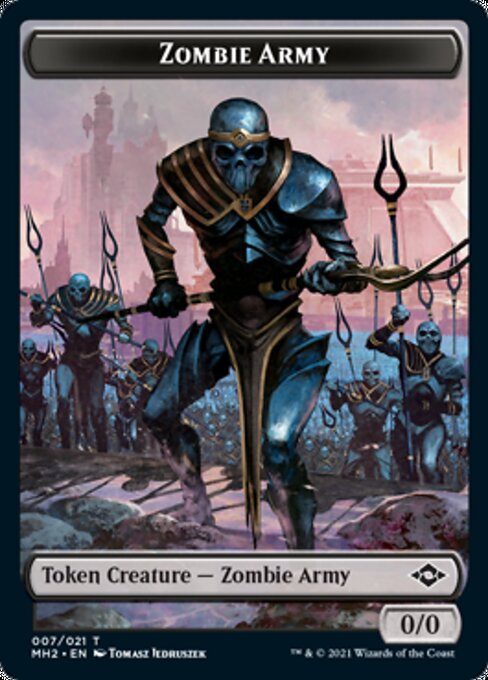 Zombie Army × 2 Zombie Army × 2 | 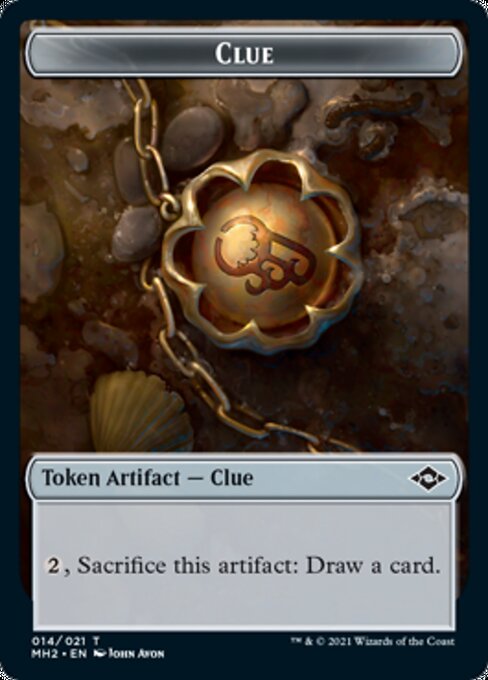 Clue × 6 Clue × 6 |  Clue × 6 Clue × 6 |
 Food × 6 Food × 6 | 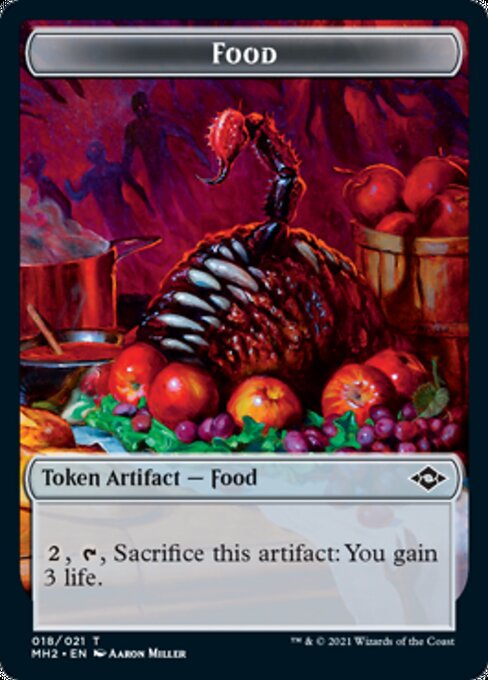 Food × 6 Food × 6 |  Treasure × 8 Treasure × 8 |
 Treasure × 8 Treasure × 8 |  Beast × 10 Beast × 10 |  Bird × 10 Bird × 10 |
 Crab × 10 Crab × 10 |  Thopter × 10 Thopter × 10 |  Squirrel × 22 Squirrel × 22 |
| Tokens (With Reverse Side) |
|---|
|
The Belgian printing uses sequential collation with a non-standard common collation scheme. Possibly this scheme is used because there are so many commons that have alternate versions.
Packs are front-facing and have common-uncommon-rare ordering followed by an ad card. There are 10 commons, 3 uncommons, and 1 rare. Between the uncommons and the rare is a new-to-Modern reprinted card (which can be uncommon, rare, or mythic). If there is a foil, it will displace a common and appear after the rare.
| 10 Commons | 3 Uncommons | 1 Reprint | 1 Rare | 1 Ad Card | |
| 9 Commons | 3 Uncommons | 1 Reprint | 1 Rare | 1 Foil | 1 Ad Card |
There are three commons runs. The A and B runs each contain 40 distinct cards repeated 3 times each plus one copy of Bottle Golems. The C run contains 20 distinct cards repeated 6 times each. this makes Bottle Golems a 2/3 short-print. Each pack contains 4A+4B+2C. For commons with special variations, a third of the copies are the special version. A foil can displace a common from any of these runs, probably proportionate with their as-fan.
The A common run consists of 40 different cards each appearing three times plus Bottle Golems, the short-printed common. For cards with sketch or old border versions, one of the three copies is the special version. The choice of first card is mostly arbitrary.
 |  |  |  |  |  |  |  |  |  |  |
 |  |  |  |  |  |  |  |  |  |  |
 |  |  |  |  |  |  |  |  |  |  |
 |  |  |  |  |  |  |  |  |  |  |
 |  |  |  |  |  |  |  |  |  |  |
 |  |  |  |  |  |  |  |  |  |  |
 |  |  |  |  |  |  |  |  |  |  |
 |  |  |  |  |  |  |  |  |  |  |
 |  |  |  |  |  |  |  |  |  |  |
 |  |  |  |  |  |  |  |  |  |  |
 |  |  |  |  |  |  |  |  |  |  |
The B common run consists of 40 different cards each appearing three times plus Bottle Golems, the short-printed common. For cards with sketch or old border versions, one of the three copies is the special version. The choice of first card is mostly arbitrary.
 |  |  |  |  |  |  |  |  |  |  |
 |  |  |  |  |  |  |  |  |  |  |
 |  |  |  |  |  |  |  |  |  |  |
 |  |  |  |  |  |  |  |  |  |  |
 |  |  |  |  |  |  |  |  |  |  |
 |  |  |  |  |  |  |  |  |  |  |
 |  |  |  |  |  |  |  |  |  |  |
 |  |  |  |  |  |  |  |  |  |  |
 |  |  |  |  |  |  |  |  |  |  |
 |  |  |  |  |  |  |  |  |  |  |
 |  |  |  |  |  |  |  |  |  |  |
The C common run consists of 20 different cards each appearing six times. For cards with old border versions, two of the six copies are the old border version. The choice of first card is mostly arbitrary.
 |  |  |  |  |  |  |  |  |  |  |
 |  |  |  |  |  |  |  |  |  |  |
 |  |  |  |  |  |  |  |  |  |  |
 |  |  |  |  |  |  |  |  |  |  |
 |  |  |  |  |  |  |  |  |  |  |
 |  |  |  |  |  |  |  |  |  |  |
 |  |  |  |  |  |  |  |  |  |  |
 |  |  |  |  |  |  |  |  |  |  |
 |  |  |  |  |  |  |  |  |  |  |
 |  |  |  |  |  |  |  |  |  |  |
 |  |  |  |  |  |  |  |  |  |
The Japanese printing uses sequential collation with 112 card sheets (which is the usual for Japan). Probably the sheets are 14 × 8.
Packs are front-facing starting with the ad or placeholder card, then the rare, the new-to-Modern reprint, 3 uncommons, and 10 commons. If there is a foil, it will appear before the rare, displacing a common.
| 1 Ad or Placeholder Card | 1 Rare | 1 Reprint | 3 Uncommons | 10 Commons | |
| 1 Ad or Placeholder Card | 1 Foil | 1 Rare | 1 Reprint | 3 Uncommons | 9 Commons |
There are 3 common runs: A, B, and C. A contains 27 distinct cards each appearing four times. Between the B and C runs, there are 74 distinct cards each appearing three times. The cards with special versions are on B and C, but the special version isn't always in the same run as the normal version. B contains normal versions of 36 cards and special versions of 16 cards. One of the special versions is a card for which the normal version is in C, and 4 of the special versions have their normal versions in C. In complementary fashion, C contains normal versions of 38 cards and special versions of 7 cards. One of the special versions is a card for which the normal version is in B. Each pack gets 2 to 3 cards from A followed by 3 to 4 cards from B and 3 to 4 cards from C. This means packs are either 2-4-4, 3-3-4, or 3-4-3. The exact ratios may depend on the way foil collation works.
| A | A | B | B | B | B | C | C | C | C |
| A | A | A | B | B | B | C | C | C | C |
| A | A | A | B | B | B | B | C | C | C |
Foils displace a common. As far as I've seen, there will still be at least 2 A commons, 3 B commons, and 3 C commons, and I have seen all three possibilities for common distribution given a foil.
The A common run consists of 27 different cards each appearing four times (which would leave 4 fillers on a 112 card sheet). The choice of first card is mostly arbitrary.
 |  |  |  |  |  |  |  |
 |  |  |  |  |  |  |  |
 |  |  |  |  |  |  |  |
 |  |  |  |  |  |  |  |
 |  |  |  |  |  |  |  |
 |  |  |  |  |  |  |  |
 |  |  |  |  |  |  |  |
 |  |  |  |  |  |  |  |
 |  |  |  |  |  |  |  |
 |  |  |  |  |  |  |  |
 |  |  |  |  |  |  |  |
 |  |  |  |  |  |  |  |
 |  |  |  |  |  |  |  |
 |  |  |  |
The B common run consists of 35 different cards each appearing three times, the two copies of the normal version of Glimmer Bairn (the sketch version of which is in C), plus the sketch versions (but not the normal copies) of Kitchen Imp, Late to Dinner, Lens Flare, and World-Weary. For those out of the 35 cards that have a special version, one of the three copies is the special version. The cards are mostly red and white. The choice of first card is mostly arbitrary.
 |  |  |  |  |  |  |  |
 |  |  |  |  |  |  |  |
 |  |  |  |  |  |  |  |
 |  |  |  |  |  |  |  |
 |  |  |  |  |  |  |  |
 |  |  |  |  |  |  |  |
 |  |  |  |  |  |  |  |
 |  |  |  |  |  |  |  |
 |  |  |  |  |  |  |  |
 |  |  |  |  |  |  |  |
 |  |  |  |  |  |  |  |
 |  |  |  |  |  |  |  |
 |  |  |  |  |  |  |  |
 |  |  |  |  |  |  |
The C common run consists of 34 different cards each appearing three times, the two normal copies of Kitchen Imp, Late to Dinner, Lens Flare, and World-Weary, plus the old-border version of Glimmer Bairn. For those out of the 34 cards that have a special version, one of the three copies is the special version. The cards are mostly black and green. The choice of first card is mostly arbitrary.
 |  |  |  |  |  |  |  |
 |  |  |  |  |  |  |  |
 |  |  |  |  |  |  |  |
 |  |  |  |  |  |  |  |
 |  |  |  |  |  |  |  |
 |  |  |  |  |  |  |  |
 |  |  |  |  |  |  |  |
 |  |  |  |  |  |  |  |
 |  |  |  |  |  |  |  |
 |  |  |  |  |  |  |  |
 |  |  |  |  |  |  |  |
 |  |  |  |  |  |  |  |
 |  |  |  |  |  |  |  |
 |  |  |  |  |  |  |